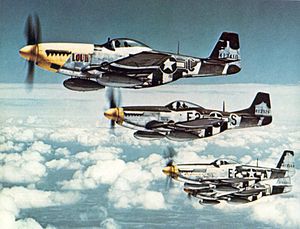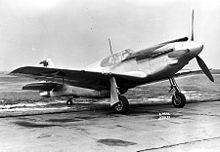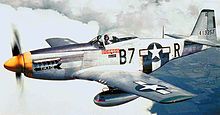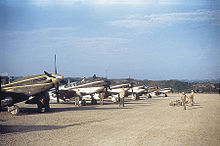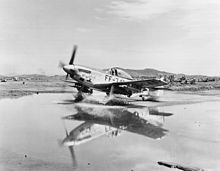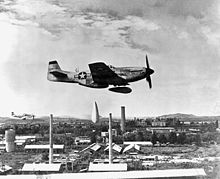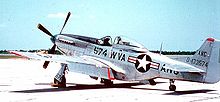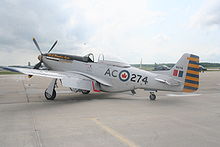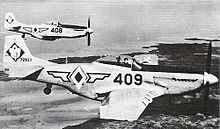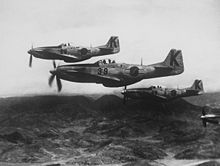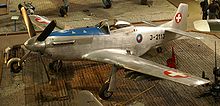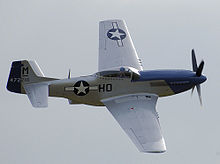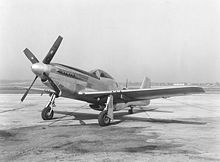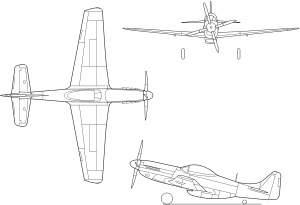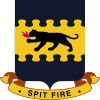- North American P-51 Mustang
-
"P-51" redirects here. For other uses, see P51 (disambiguation).
P-51 Mustang P-51 Mustangs of the 375th Fighter Squadron, 361st Fighter Group, Eighth Air Force mid-1944. The aircraft second from the camera has the newly-introduced dorsal fin. Role Fighter National origin United States Manufacturer North American Aviation First flight 26 October 1940 Introduction 1942 Status Retired from military service 1984, still in civil use Primary users United States Army Air Forces
Royal Air Force, numerous others (see below)Number built More than 15,000[1] Unit cost US$50,985 in 1945[2] Variants North American A-36
Rolls-Royce Mustang Mk.X
Cavalier MustangDeveloped into F-82 Twin Mustang
Piper PA-48 EnforcerThe North American Aviation P-51 Mustang was an American long-range, single-seat fighter and fighter-bomber used during World War II, the Korean War and in several other conflicts. During World War II Mustang pilots claimed 4,950 enemy aircraft shot down, the most of any Allied fighter.
It was conceived, designed and built by North American Aviation (NAA), under the direction of lead engineer Edgar Schmued, in response to a specification issued directly to NAA by the British Purchasing Commission; the prototype NA-73X airframe was rolled out, although without an engine, 102 days after the contract was signed.[3] The Mustang was originally designed to use a low-altitude rated Allison V-1710 engine, and was first flown operationally by the Royal Air Force (RAF) as a tactical-reconnaissance aircraft and fighter-bomber. The definitive version, the P-51D, was powered by the Packard V-1650-7, a licence-built version of the Rolls-Royce Merlin 60 series two-stage two-speed supercharged engine, and armed with six .50 caliber (12.7 mm) M2 Browning machine guns.
From late 1943, P-51Bs (supplemented by P-51Ds from mid-1944) were used by the USAAF's Eighth Air Force to escort bombers in raids over Germany, while the RAF's 2 TAF and the USAAF's Ninth Air Force used the Merlin-powered Mustangs as fighter-bombers, roles in which the Mustang helped ensure Allied air superiority in 1944.[4] The P-51 was also in service with Allied air forces in the North African, Mediterranean and Italian theatres, and saw limited service against the Japanese in the Pacific War.
At the start of Korean War the Mustang was the main fighter used by the United Nations. Jet fighters, including the F-86, took over this role, and the Mustang became a specialized ground-attack fighter-bomber.
Despite the advent of jet fighters, the Mustang remained in service with some air forces until the early 1980s. After World War II and the Korean War, many Mustangs were converted for civilian use, especially air racing.
Contents
Design and development
Genesis
Main article: North American P-51 variantsIn April 1938, shortly after the German Anschluss of Austria, the British government established a purchasing commission in the United States, headed by Sir Henry Self.[5] Self was given overall responsibility for Royal Air Force (RAF) production and research and development, and also served with Sir Wilfrid Freeman, the "Air Member for Development and Production". Self also sat on the British Air Council Sub-committee on Supply (or "Supply Committee") and one of his many tasks was to organize the manufacturing and supply of American fighter aircraft for the RAF. At the time, the choice was very limited as no U.S. aircraft already flying met European standards, with only the Curtiss P-40 Tomahawk coming close. The Curtiss-Wright plant was running at capacity, so even P-40s were in short supply.[6]
North American Aviation (NAA) was already supplying its Harvard trainer to the RAF, but was otherwise underutilized. NAA President "Dutch" Kindelberger approached Self to sell a new medium bomber, the B-25 Mitchell. Instead, Self asked if NAA could manufacture the Tomahawk under license from Curtiss.
Kindelberger said NAA could have a better aircraft with the same engine in the air in less time than it would take to set up a production line for the P-40. The Commission stipulated armament of four .303 in (7.7 mm) machine guns, the Allison V-1710 liquid-cooled engine, a unit cost of no more than $40,000, and delivery of the first production aircraft by January 1941.[7] In March 1940, 320 aircraft were ordered by Sir Wilfred Freeman who had become the executive head of Ministry of Aircraft Production (MAP), and the contract was promulgated on 24 April.[8]
The design, known as the NA-73X, followed the best conventional practice of the era, but included several new features. One was a wing designed using laminar flow airfoils developed in a collaboration between NACA and North American Aviation. These airfoils, designated NAA/NACA 45-100, were associated with very low drag at high speeds.[9][10] During the development of the NA-73X, a wind tunnel test of two wings, one using NACA 5-digit airfoils and the other using the new NAA/NACA 45-100 airfoils, was performed in the University of Washington Kirsten Wind Tunnel. The results of this test showed the superiority of the wing designed with the NAA/NACA 45-100 airfoils.[11] The other feature was a new radiator design that exploited the "Meredith Effect", in which heated air exited the radiator as a form of jet thrust. Because NAA lacked a suitable wind tunnel to test this feature, it used the GALCIT 10 ft (3.0 m) wind tunnel at Caltech. This led to some controversy over whether the Mustang's cooling system aerodynamics were developed by NAA's engineer Edgar Schmued or by Curtiss, although NAA had purchased the complete set of P-40 and XP-46 wind tunnel data and flight test reports for US$56,000.[12] The NA-73X was also one of the first aircraft to have a fuselage lofted mathematically using conics. This resulted in the aircraft's fuselage having smooth, low drag, surfaces.[13][14]
The prototype NA-73X was rolled out in early August and first flew on 26 October 1940,[8] respectively just 117 and 178 days after the order had been placed, an uncommonly short gestation period. The prototype handled well and the internal arrangement accommodated an impressive fuel load. The aircraft’s two-section, semi-monocoque fuselage was constructed entirely of aluminum to save weight. It was armed with four .30 in (7.62 mm) M1919 Browning machine guns, two in the wings and two mounted under the engine and firing through the propeller arc using gun synchronizing gear.
While the United States Army Air Corps (USAAC) could block any sales it considered detrimental to the interests of the United States, the NA-73 was considered to be a special case because it had been designed at the instigation of the British. In September 1940 a further 300 NA-73s were ordered by MAP.[7] To ensure uninterrupted delivery Colonel Oliver P. Echols arranged with the Anglo-French Purchasing Commission to deliver the aircraft, and NAA gifted two examples to the USAAC for evaluation.[15]
Operational history
U.S. operational service
Prior to the P-51
Pre-war doctrine of most bomber forces was to attack at night when the bombers would be effectively immune to interception. In theory, the loss in accuracy due to limited visibility was a high price to pay, protecting small targets from attack. The RAF did attempt several long-range daylight raids early in the war using the Vickers Wellington, but suffered such high casualties that they gave up the effort very quickly. The Luftwaffe had the advantage of bases in France that allowed their fighters to escort the bombers at least part way on their missions. Nevertheless, this strategy proved ineffective as the RAF fighters simply ignored the escorts and attacked the bombers. The Germans too gave up on day bombing and switched to night bombing during The Blitz of 1940/41.
American pre-war doctrine developed out of an isolationist policy that was primarily centred on defence. The B-17 had originally been designed to attack shipping at long range from the US shores. For this role it needed to be able to attack in daylight and used the advanced Norden bombsight to improve accuracy. As the bomber developed, more and more defensive armament was added to outgun the fighters it would face. In light of this heavy defensive firepower, the USAAC came to believe that tightly packed formations of B-17s would have so much firepower that they could fend off fighters on their own. In spite of evidence to the contrary from the RAF and Luftwaffe, this strategy was believed to be sound, and when the US entered the war they put this strategy into force, building up a strategic bomber force based in Britain.
The 8th Air Force started operations from Britain in August 1942; at first, because of the limited scale of operations, there was no conclusive evidence that the American doctrine was failing. In the 26 operations which had been flown to the end of 1942 the loss rate had been under 2%.[16] In January 1943, at the Casablanca Conference, the Allies formulated the Combined Bomber Offensive (CBO) plan for "round-the-clock" bombing by the RAF at night and the USAAF by day. In June 1943, the Combined Chiefs of Staff issued the Pointblank Directive to destroy the Luftwaffe before the invasion of Europe, putting the CBO into full implementation. Following this, the 8th Air Force's heavy-bombers conducted a series of deep-penetration raids into Germany, beyond the range of available escort fighters. German fighter reaction was fierce, and bomber losses were severe—20% in an October 14 attack on the German ball-bearing industry. This made it too costly to continue such long-range raids without adequate fighter escort.
The Lockheed P-38 Lightning had the range to escort the bombers, but was only available in very limited numbers in the European theater due to its Allison engines proving difficult to maintain. It was also a very expensive aircraft to build and operate. The Republic P-47 Thunderbolt was capable of meeting the Luftwaffe on more than even terms, but did not at the time have sufficient range. The Luftwaffe quickly identified its maximum range, and their fighters waited for the bombers just beyond the point where the Thunderbolts had to turn back.
P-51 introduction
The Mustang changed all that. In general terms, the Mustang was at least as simple as other aircraft of its era. It used a single, well-understood, reliable engine and had internal space for a huge fuel load. With external fuel tanks, it could accompany the bombers all the way to Germany and back. Enough P-51s became available to the 8th and 9th Air Forces in the winter of 1943–44. When the Pointblank offensive resumed in early 1944, matters changed dramatically. The P-51 proved perfect for the task of escorting bombers all the way to the deepest targets. The Eighth Air Force immediately began to switch its fighter groups to the Mustang, first exchanging arriving P-47 groups for those of the 9th Air Force using P-51s, then gradually converting its Thunderbolt and Lightning groups. The defence was initially layered, using the shorter range P-38s and P-47s to escort the bombers during the initial stages of the raid, and then handing over to the P-51 when they turned for home. By the end of 1944, 14 of its 15 groups flew the Mustang.[17]
The Luftwaffe initially adapted to the U.S. fighters by modifying their pre-P-51 doctrine, massing in front of the bombers and then attacking in a single pass through the formation. The P-51s, flying in close formation with the bombers, had little time to react before the attackers were already running out of range where they were allowed to pursue. In order to better deal with the bombers, the Luftwaffe started increasing the armament on their fighters with heavy cannons. The weight of this armament decreased performance to the point where their aircraft were sitting ducks if caught by the P-51s. At first this was relatively easy to avoid.
Destroying the Luftwaffe
The U.S. responded with a doctrine change of its own. In early 1944, General James Doolittle told the fighters to stop flying in formation with the bombers, and instead attack the Luftwaffe wherever it could be found. The Mustang groups were sent in before the bombers and could hunt down the German fighters while they were still attempting to form up. The results were astonishing, in a short period of just over a week, the Luftwaffe lost 17% of its fighter pilots.[18] As Doolittle later noted, "Adolf Galland said that the day we took our fighters off the bombers and put them against the German fighters, that is, went from defensive to offensive, Germany lost the air war."[19]
The Luftwaffe answer was the Gefechtsverband (battle formation). It consisted of a Sturmgruppe of heavily armed and armored Fw 190s escorted by two Begleitgruppen of light fighters, often Bf 109Gs, whose task was to keep the Mustangs away from the Fw 190s attacking the bombers. This scheme was excellent in theory but difficult to apply in practice. The massive German formation took a long time to assemble and was difficult to maneuver. It was often intercepted by the escorting P-51s and broken before reaching the bombers. But when the Sturmgruppe worked, the effects were devastating. With their engines and cockpits heavily armored, the Fw 190s attacked from astern and gun camera films show that these attacks were often pressed to within 100 yds.[20]
While not always successful in avoiding contact with the escorts, the threat of mass attacks, and later the "company front" (eight abreast) assaults by armored Sturmgruppe Fw 190s, brought an urgency to attacking the Luftwaffe wherever it could be found. Beginning in late February 1944, 8th Air Force fighter units began systematic strafing attacks on German airfields that picked up in frequency and intensity throughout the spring, with the objective of gaining air supremacy over the Normandy battlefield. In general, these were conducted by units returning from escort missions, but beginning in March, many groups also were assigned airfield attacks instead of bomber support. The P-51, particularly with the advent of the K-14 gunsight and the development of "Clobber Colleges" for the in-theater training of fighter pilots in fall 1944, was a decisive element in Allied countermeasures against the Jagdverbände.
The numerical superiority of the USAAF fighters, superb flying characteristics of the P-51 and pilot proficiency helped cripple the Luftwaffe's fighter force. As a result, the fighter threat to US, and later British bombers, was greatly diminished by July 1944. Reichmarshal Hermann Göring, commander of the German Luftwaffe during the war, was quoted as saying, "When I saw Mustangs over Berlin, I knew the jig was up."[21][22]
Mopping up
On 15 April, VIII FC began Operation Jackpot, attacks on specific Luftwaffe fighter airfields. As the efficacy of these missions took effect, the number of fighters at the German airbases fell to the point where they were no longer useful targets, and on 21 May, targets were expanded to include railways, locomotives, and rolling stock used by the Germans to transport materiel and troops, in missions dubbed "Chattanooga".[23] The P-51 also excelled at this mission, although losses were much higher on strafing missions than in air-to-air combat, partially because, like other fighters using liquid-cooled engines, the Mustang's coolant system could be punctured by small arms hits, even from a single bullet.
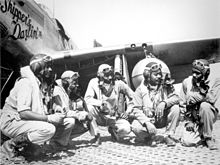 Pilots of all-African American 332nd Fighter Group (the Tuskegee Airmen) at Ramitelli, Italy. From left, Lt. Dempsey W. Morgran, Lt. Carroll S. Woods, Lt. Robert H. Nelron, Jr., Capt. Andrew D. Turner and Lt. Clarence P. Lester
Pilots of all-African American 332nd Fighter Group (the Tuskegee Airmen) at Ramitelli, Italy. From left, Lt. Dempsey W. Morgran, Lt. Carroll S. Woods, Lt. Robert H. Nelron, Jr., Capt. Andrew D. Turner and Lt. Clarence P. Lester
Given the overwhelming Allied air superiority, the Luftwaffe put its effort into the development of aircraft of such high performance that they could operate with impunity. Foremost among these were the Messerschmitt Me 163 rocket interceptors and Messerschmitt Me 262 jet fighter. In action, the Me 163 proved to be more dangerous to the Luftwaffe than to the Allies, and was never a serious threat. The Me 262 was, however, but continued operations against their airfields largely nullified their effect.Furthermore the unreliable jet engines of the Me 262s needed careful nursing by their pilots and these aircraft were particularly vulnerable during take-off and landing.[24] Lt. Chuck Yeager of the 357th Fighter Group was one of the first American pilots to shoot down a Me 262 which he caught during its landing approach. On 7 October 1944, Lt. Urban Drew of the 365th Fighter Group shot down two Me 262s that were taking off, while on the same day Lt. Col. Hubert Zemke, who had transferred to the Mustang equipped 479th Fighter Group, shot down what he thought was a Bf 109, only to have his gun camera film reveal that it may have been an Me 262.[25]
The Mustang also proved useful against the V-1s launched toward London. P-51B/Cs using 150 octane fuel were fast enough to catch the V-1, and operated in concert with shorter-range aircraft like advanced marks of the Supermarine Spitfire and Hawker Tempest.
 P-51D 44-14888 of the 8th AF/357th FG/363rd FS, named Glamorous Glennis III, is the aircraft in which Chuck Yeager, the future test pilot, achieved most of his 12.5 kills, including two Me 262s
P-51D 44-14888 of the 8th AF/357th FG/363rd FS, named Glamorous Glennis III, is the aircraft in which Chuck Yeager, the future test pilot, achieved most of his 12.5 kills, including two Me 262s
By 8 May 1945,[26] the 8th, 9th and 15th Air Forces' P-51 groups [nb 1] claimed some 4,950 aircraft shot down (about half of all USAAF claims in the European theater), the most claimed by any Allied fighter in air-to-air combat,[26] and 4,131 destroyed on the ground. Losses were about 2,520 aircraft.[27] The 8th Air Force's 4th Fighter Group, was the overall top-scoring fighter group in Europe, with 1,016 enemy aircraft claimed destroyed. This included 550 claimed in aerial combat and 466 on the ground.[28]
In aerial combat, the top-scoring P-51 units (both of which exclusively flew Mustangs) were the 357th Fighter Group of the 8th Air Force with 565 air-to-air combat victories, and the Ninth Air Force's 354th Fighter Group with 664, which made it one of the top scoring fighter groups in aerial combat. Martin Bowman reports that in the European Theater of Operations, Mustangs flew 213,873 sorties and lost 2,520 aircraft to all causes.[citation needed] The top Mustang ace was the USAAF's George Preddy, whose final tally stood at 26.333, 23 scored with the P-51, when he was shot down and killed by friendly fire on Christmas Day 1944 during the Battle of the Bulge.[26]
In the Pacific Theatre
The P-51 was a relative latecomer to the Pacific Theatre. This was due largely to the need for the aircraft in Europe, although the P-38's twin-engine design was considered a safety advantage for long over-water flights. The first P-51s were deployed in the Far East later in 1944, operating in close-support and escort missions as well as for tactical photo reconnaissance. As the war in Europe wound down, the P-51 became more common: eventually, with the capture of Iwo Jima, it was able to be used as a bomber escort during B-29 Superfortress missions against the Japanese homeland.
Expert opinions
Chief Naval Test Pilot and C.O. Captured Enemy Aircraft Flight Capt. Eric Brown, CBE, DSC, AFC, RN, tested the Mustang in RAE Farnborough, and noted: "The Mustang was a good fighter and the best escort due to its incredible range, make no mistake about it. It was also the best American dogfighter. But the laminar flow wing fitted to the Mustang could be a little tricky. It could not by any means out-turn a Spitfire. No way. It had a good rate-of-roll, better than the Spitfire, so I would say the plusses to the Spitfire and the Mustang just about equate. If I were in a dogfight, I’d prefer to be flying the Spitfire. The problem was I wouldn’t like to be in a dogfight near Berlin, because I could never get home to Britain in a Spitfire!"[29]
Luftwaffe Experten were confident that they could out-maneuver the P-51 in a dogfight. Kurt Bühligen, the third-highest scoring German fighter pilot of the Second World War on the Western Front, with 112 victories, later recalled that "We would out-turn the P-51 and the other American fighters, with the (Bf) "109" or the (Fw) "190". Their turn rate was about the same. The P-51 was faster than us but our munitions and cannon were better."[30] Robert S. Johnson, the second-highest scoring U.S. fighter pilot in European theatre flew the P-47 against German fighters. Johnson pointed out: "Generally speaking, I’d say the best (Focke-Wulf) 190s and the P-51 were very close in performance; the difference was probably in the pilot in these combats."[31]
Post-World War II
In the aftermath of World War II, the USAAF consolidated much of its wartime combat force and selected the P-51 as a "standard" piston-engine fighter, while other types, such as the P-38 and P-47, were withdrawn or given substantially reduced roles. However, as more advanced jet fighters (P-80 and P-84) were being introduced, the P-51 was relegated to secondary status.
In 1947, the newly-formed USAF Strategic Air Command employed Mustangs alongside F-6 Mustangs and F-82 Twin Mustangs, due to their range capabilities. In 1948, the designation P-51 (P for pursuit) was changed to F-51 (F for fighter), and the existing F designator for photographic reconnaissance aircraft was dropped because of a new designation scheme throughout the USAF. Aircraft still in service in the USAF or Air National Guard (ANG) when the system was changed included: F-51B, F-51D, F-51K, RF-51D (formerly F-6D), RF-51K (formerly F-6K), and TRF-51D (two-seat trainer conversions of F-6Ds). They remained in service from 1946 through 1951. By 1950, although Mustangs continued in service with the USAF after the war, the majority of the USAF's Mustangs had been surplussed or transferred to the Air Force Reserve (AFRES) and the Air National Guard (ANG).
During the Korean War, F-51s, though obsolete as fighters, were used as close ground-support aircraft and reconnaissance aircraft until the end of the war in 1953.[32] Because of its lighter structure and less availability of spare parts, the newer, faster F-51H was not used in Korea. With the aircraft being used for ground attack, its performance was less of a concern than its ability to carry a load.
At the start of the Korean War, the Mustang once again proved its usefulness. With the availability of F-51Ds in service and in storage, a substantial number were shipped via aircraft carriers to the combat zone for use initially by both the Republic of Korea Air Force (ROKAF) and USAF. Rather than employing them as interceptors or "pure" fighters, the F-51 was given the task of ground attack, fitted with rockets and bombs. After the initial invasion from North Korea, USAF units were forced to fly from bases in Japan, and F-51Ds could hit targets in Korea that short-ranged F-80 jet fighters could not. A major concern over the vulnerability of the cooling system was realized in heavy losses due to ground fire. Mustangs continued flying with USAF and ROKAF fighter-bomber units on close support and interdiction missions in Korea until they were largely replaced by Republic F-84 and Grumman Panther jet fighter-bombers in 1953. No. 77 Squadron Royal Australian Air Force (RAAF) operated Australian-built Mustangs as part of British Commonwealth Forces Korea, replacing them with Gloster Meteor F8s in 1951. No. 2 Squadron South African Air Force (SAAF) operated US-built Mustangs as part of the US 18th Fighter Bomber Wing, suffering heavy losses by 1953, when it converted to the F-86 Sabre.
F-51s flew in the Air Force Reserve and Air National Guard throughout the 1950s. The last American USAF Mustang was F-51D-30-NA AF Serial No. 44-74936, which was finally withdrawn from service with the West Virginia Air National Guard in 1957. This aircraft is now on display at the National Museum of the United States Air Force at Wright-Patterson AFB in Dayton, Ohio. It is, however, painted as P-51D-15-NA Serial No. 44-15174.[33]
The final withdrawal of the Mustang from USAF dumped hundreds of P-51s out onto the civilian market. The rights to the Mustang design were purchased from North American by the Cavalier Aircraft Corporation, which attempted to market the surplus Mustang aircraft both in the U.S. and overseas. In 1967 and again in 1972, the USAF procured batches of remanufactured Mustangs from Cavalier, most of them destined for air forces in South America and Asia that were participating in the Military Assistance Program (MAP). These aircraft were remanufactured from existing original F-51D airframes but were fitted with new V-1650-7 engines, a new radio fit, tall F-51H-type vertical tails, and a stronger wing that could carry six 0.50 in (13 mm) machine guns and a total of eight underwing hardpoints. Two 1,000 lb (454 kg) bombs and six 5 in (127 mm) rockets could be carried. They all had an original F-51D-type canopy, but carried a second seat for an observer behind the pilot. One additional Mustang was a two-seat dual-control TF-51D (67-14866) with an enlarged canopy and only four wing guns. Although these remanufactured Mustangs were intended for sale to South American and Asian nations through the MAP, they were delivered to the USAF with full USAF markings. They were, however, allocated new serial numbers (67-14862/14866, 67-22579/22582 and 72-1526/1541).[33]
The last U.S. military use of the F-51 was in 1968, when the U. S. Army employed a vintage F-51D (44-72990) as a chase aircraft for the Lockheed YAH-56 Cheyenne armed helicopter project. This aircraft was so successful that the Army ordered two F-51Ds from Cavalier in 1968 for use at Fort Rucker as chase planes. They were assigned the serials 68-15795 and 68-15796. These F-51s had wingtip fuel tanks and were unarmed. Following the end of the Cheyenne program, these two chase aircraft were used for other projects. One of them (68-15795) was fitted with a 106 mm recoilless rifle for evaluation of the weapon's value in attacking fortified ground targets.[34] Cavalier Mustang 68-15796 survives at the Air Force Armament Museum, Eglin AFB, Florida, displayed indoors in World War II markings.
The F-51 was adopted by many foreign air forces and continued to be an effective fighter into the mid-1980s with smaller air arms. The last Mustang ever downed in battle occurred during Operation Power Pack in the Dominican Republic in 1965, with the last aircraft finally being retired by the Dominican Air Force (FAD) in 1984.[35]
Non-US service
After World War II, the P-51 Mustang served in the air arms of more than 55 nations.[4] During wartime, a Mustang cost about 51,000 dollars,[2] while many hundreds were sold postwar for the nominal price of one dollar to the American countries that signed the Inter-American Treaty of Reciprocal Assistance, ratified in Rio de Janeiro in 1947.[36] Following is a list of some of the countries that used the P-51 Mustang.
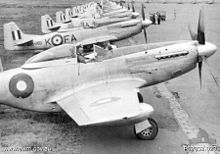 Australian P-51Ds of 82 Squadron RAAF in Bofu, Japan, as part of the British Commonwealth Occupation Force, in 1947
Australian P-51Ds of 82 Squadron RAAF in Bofu, Japan, as part of the British Commonwealth Occupation Force, in 1947
- In November 1944, 3 Squadron RAAF became the first Royal Australian Air Force unit to use Mustangs. At the time of its conversion from the P-40 to the Mustang the squadron was based in Italy with the RAF's First Tactical Air Force. By this time, the Australian government had also decided to order Australian-built Mustangs, to replace its Curtiss Kittyhawks and CAC Boomerangs in the South West Pacific theatre. The Commonwealth Aircraft Corporation (CAC) factory at Fishermans Bend, Melbourne was the only non-U.S. production line for the P-51.
- In 1944, 100 P-51Ds were shipped from the US in kit form to inaugurate production. From February 1945, CAC assembled 80 of these under the designation CA-17 Mustang Mark 20, with the first one being handed over to the RAAF on 4 June 1945.[37] The remaining 20 were kept unassembled as spare parts. In addition, 84 P-51Ks were also shipped directly to the RAAF from the USA.
- In late 1946 CAC was given another contract to build 170 (reduced to 120) more P-51Ds on its own; these, designated CA-18 Mustang Mark 21, Mark 22 or Mark 23, were manufactured entirely in-house, with only a few components being sourced from overseas.[37] The 21 and 22 used the American-built Packard V-1650-3 or V-1650-7. The Mark 23s[nb 2], which followed the 21s, were powered by Rolls-Royce Merlin 66 or Merlin 70 engines. The first 26 were built as Mark 21s, followed by 66 Mark 23s; the first 14 Mark 21s were converted to fighter-reconnaissance aircraft, with two F24 cameras in both vertical and oblique positions in the rear fuselage, above and behind the radiator fairing; the designation of these modified Mustangs was changed from Mark 21 to Mark 22. An additional 14 purpose-built Mark 22s, built after the Mark 23s, and powered by either Packard V-1650-7s or Merlin 68s, completed the production run.[37] All of the CA-17s and CA-18s, plus the 84 P-51Ks, used Australian serial numbers prefixed by A68.
- 3 Squadron was renumbered 4 Squadron after returning to Australia from Italy and converted to CAC-built Mustangs. Several other Australian or Pacific based squadrons converted to P-51s from July 1945, having been equipped with P-40s or Boomerangs for wartime service; these units were: 76, 77, 82, 83, 84 and 86 Squadrons. Only 17 Mustangs reached the RAAF's First Tactical Air Force front line squadrons by the time World War II ended in August 1945.
- 76, 77 and 82 Squadrons were formed into 81 Fighter Wing of the British Commonwealth Air Force (BCAIR) which was part of the British Commonwealth Occupation Force (BCOF) stationed in Japan from February 1946. 77 Squadron used its P-51s extensively during the first years of the Korean War, before converting to Gloster Meteor jets.[38]
- Five reserve units from the Citizen Air Force (CAF) also operated Mustangs. 21 "City of Melbourne" Squadron, based in the state of Victoria; 22 "City of Sydney" Squadron, based in New South Wales; 23 "City of Brisbane" Squadron, based in Queensland; 24 "City of Adelaide" Squadron, based in South Australia; and 25 "City of Perth" Squadron, based in Western Australia. The last Mustangs were retired from these units in 1960 when CAF units adopted a non-flying role.[39]
- In October 1953, six Mustangs, including A68-1, the first Australian built CA-17 Mk 20, were allotted to the Long Range Weapons Development Establishment at Maralinga, South Australia, for use in experiments to gauge the effects of low-yield nuclear atomic bombs. The Mustangs were placed on a dummy airfield about 0.62 mi (1 km) from the blast tower on which two low-yield bombs were detonated. The Mustangs survived intact. In 1967, A68-1 was bought by a US syndicate, for restoration to flight status and is currently owned by Troy Sanders.[40]
 Bolivia
Bolivia- Nine Cavalier F-51D (including the two TF-51s) were given to Bolivia, under a program called Peace Condor.[41]
 Canada
Canada- Canada had five squadrons equipped with Mustangs during World War II. RCAF 400, 414 and 430 squadrons flew Mustang Mk Is (1942-1944), and 441 and 442 Squadrons flew Mustang Mk IIIs and IVAs in 1945. Postwar, a total of 150 Mustang P-51Ds were purchased and served in two regular (416 "Lynx" and 417 "City of Windsor") and six auxiliary fighter squadrons (402 "City of Winnipeg", 403 "City of Calgary", 420 "City of London", 424 "City of Hamilton", 442 "City of Vancouver" and 443 "City of New Westminster"). The Mustangs were declared obsolete in 1956, but a number of special-duty versions served on into the early 1960s.
 China
China- China acquired P-51Cs and P-51Ds from the U.S. 10th AF in India by early 1945. These Mustangs were provided to the 3rd, 4th and 5th Fighter Groups of the China Air Force (CAF) and used to attack Japanese targets in occupied areas of China. After the war Chiang Kai-shek's Nationalist government used the planes against insurgent Communist forces. The Nationalists retreated to Taiwan in 1949. Pilots supporting Chiang brought most of the Mustangs with them, where the aircraft became part of the island's defence arsenal. Taiwan subsequently acquired additional Mustangs from the USAF and other sources. Some Mustangs remained on the mainland, captured by Communist forces when the Nationalists left.[41]
 Costa Rica
Costa Rica- The Costa Rica Air Force flew four P-51Ds from 1955 to 1964.[41]
 Cuba
Cuba- In November 1958, three US-registered civilian P-51D Mustangs were illegally flown separately from Miami to Cuba, on delivery to the rebel forces of the 26th of July Movement, then headed by Fidel Castro during the Cuban Revolution. One of the Mustangs was damaged during delivery, and none of them was used operationally. After the success of the revolution in January 1959, with other rebel aircraft plus those of the existing Cuban government forces, they were adopted into the Fuerza Aérea Revolucionaria. Due to increasing US restrictions, lack of spares and maintenance experience, they never achieved operational status. At the time of the Bay of Pigs invasion, the two intact Mustangs were already effectively grounded at Campo Columbia and at Santiago. After the failed invasion, they were placed on display with other symbols of "revolutionary struggle", and one remains on display at the Museo del Aire (Cuba).[42][43][page needed][44]
 Dominican Republic
Dominican Republic- The Dominican Republic (FAD) was the largest Latin American air force to employ the P-51D, with six aircraft acquired in 1948, 44 ex-Swedish F-51Ds purchased in 1948 and a further Mustang obtained from an unknown source.[45] It was the last nation to have any Mustangs in service, with some remaining in use as late as 1984.[41]
 El Salvador
El Salvador- The FAS purchased five Cavalier Mustang IIs (and one dual control Cavalier TF-51) that featured wingtip fuel tanks to increase combat range and up-rated Merlin engines. Seven P-51D Mustangs were also in service.[41] They were used during the 1969 Soccer War against Honduras, the last time the P-51 was used in combat. One of them, FAS-404, was shot down by a F4U-5 flown by Cap. Fernando Soto in the last aerial combat between piston engine fighters in the world.[46]
 France
France- In late 1944, the first French unit began its transition to reconnaissance Mustangs. In January 1945, the Tactical Reconnaissance Squadron 2/33 of the French Air Force took their F-6Cs and F-6Ds over Germany on photographic mapping missions. The Mustangs remained in service until the early 1950s, when they were replaced by jet fighters.[41]
 Germany
Germany- Several P-51s were captured by the Luftwaffe as Beuteflugzeug (captured aircraft) following crash landings. These aircraft were subsequently repaired and test-flown by the Zirkus Rosarius, or "Rosarius Staffel", the official Erprobungskommando of the Luftwaffe High Command, for combat evaluation at Göttingen. The aircraft were repainted with German markings and bright yellow nose and belly for identification. A number of P-51B/P-51Cs (including examples marked with Luftwaffe Geschwaderkennung codes T9+CK, T9+FK, T9+HK and T9+PK) and three P-51Ds were captured.[47] Some of these P-51s were found by Allied forces at the end of the war; others crashed during testing.[48] The Mustang is also listed in the appendix to the novel KG 200 as having been flown by the German secret operations unit KG 200, which tested, evaluated and sometimes clandestinely operated captured enemy aircraft during World War II.[49]
 Guatemala
Guatemala- The Fuerza Aérea Guatemalteca (FAG) had 30 P-51D Mustangs in service from 1954 to the early 1970s.[41]
 Haiti
Haiti- Haiti had four P-51D Mustangs when President Paul Eugène Magloire was in power between 1950 and 1956, with the last retired in 1973-74 and sold for spares to the Dominican Republic.[50]
 Indonesia
Indonesia- Indonesia acquired some P-51Ds from the departing Netherlands East Indies Air Force in 1949 and 1950. The Mustangs were used against Commonwealth (RAF, RAAF and RNZAF) forces during the Indonesian confrontation in the early 1960s. The last time Mustangs were deployed for military purposes was a shipment of six Cavalier II Mustangs (without tip tanks) delivered to Indonesia in 1972–1973, which were replaced in 1976.[51][52]
 Israel
Israel- A few P-51 Mustangs were illegally bought by Israel in 1948, crated and smuggled into the country as agricultural equipment for use in the War of Independence (1948) and quickly established themselves as the best fighter in the Israeli inventory.[53] Further aircraft were bought from Sweden, and were replaced by jets at the end of the 1950s, but not before the type was used in the Suez Crisis, Operation Kadesh (1956). Reputedly, during this conflict, one daring Israeli pilot literally cut communications between Suez City and the Egyptian front lines by using his Mustang's propeller on the telephone wires.[54]
 Italy
Italy- Italy was a postwar operator of P-51Ds; deliveries were slowed by the Korean war, but between September 1947 and January 1951, by MDAP count, 173 examples were delivered. They were used in all the AMI fighter units: 2, 3, 4, 5, 6, and 51 Stormo (Wing), and some in schools and experimental units. Considered a "glamorous" fighter, P-51s were even used as personal aircraft by several Italian commanders. Some restrictions were placed on its use due to unfavorable flying characteristics. Handling had to be done with much care when fuel tanks were fully utilized and several aerobatic maneuvers were forbidden. Overall, the P-51D was highly rated even compared to the other primary postwar fighter in Italian service, the Supermarine Spitfire, partly because these P-51Ds were in very good condition in contrast to all other Allied fighters supplied to Italy. Phasing out of the Mustang began in summer 1958.[55][page needed]
 Japan
Japan- The P-51C-11-NT Evalina, marked as "278" (former USAAF serial: 44-10816) and flown by 26th FS, 51st FG, was hit by gunfire on 16 January 1945 and belly-landed on Suchon Airfield in China, which was held by the Japanese. The Japanese repaired the aircraft, roughly applied Hinomaru roundels and flew the aircraft to the Fussa evaluation centre (now Yokota Air Base) in Japan.[41]
 Netherlands
Netherlands- The Royal Netherlands East Indies Army Air Force received 40 P-51Ds and flew them during the Indonesian National Revolution particularly the two 'politionele acties': Operatie Product in 1947 and Operatie Kraai in 1949.[56] When the conflict was over, Indonesia received some of the ML-KNIL Mustangs.[41]
 Nicaragua
Nicaragua- Fuerza Aerea de Nicaragua (GN) purchased 26 P-51D Mustangs from Sweden in 1954 and later received 30 P-51D Mustangs from the US together with two TF-51 models from MAP after 1954. All aircraft of this type were retired from service by 1964.[41]
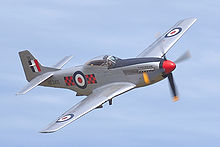 P-51D in 3 (Canterbury) Squadron TAF livery, performing at 2007 Wings over Wairarapa airshow
P-51D in 3 (Canterbury) Squadron TAF livery, performing at 2007 Wings over Wairarapa airshow
 New Zealand
New Zealand- New Zealand ordered 370 P-51 Mustangs to supplement its F4U Corsairs in the Pacific Ocean Areas theatre. Scheduled deliveries were for an initial batch of 30 P-51Ds, followed by 137 more P-51Ds and 203 P-51Ms.[57] The original 30 were being shipped as the war ended in August 1945; these were stored in their packing cases and the order for the additional Mustangs was cancelled. In 1951 the stored Mustangs entered service in 1 (Auckland), 2(Wellington), 3 (Canterbury) and 4 (Otago) squadrons of the Territorial Air Force (TAF). The Mustangs remained in service until they were prematurely retired in August 1955 following a series of problems with undercarriage and coolant system corrosion problems. Four Mustangs served on as target tugs until the TAF was disbanded in 1957.[57] RNZAF pilots in the Royal Air Force also flew the P-51, and at least one New Zealand pilot scored victories over Europe while on loan to a USAAF P-51 squadron.
The Philippines acquired 103 P-51D Mustangs after World War II. These became the backbone of the postwar Philippine Army Air Corps and Philippine Air Force and were used extensively during the Huk campaign, fighting against Communist insurgents.
Mustangs were also the first aircraft of the Philippine air demonstration squadron, which was formed in 1953 and given the name "The Blue Diamonds" the following year.[58] The Mustangs were replaced by 50 F-86 Sabres in the late 1950s, but some were still in service for COIN roles up to the early 1970s.
 People's Republic of China
People's Republic of China- See China above; the Chinese Communists captured a few P-51s from the Chinese Nationalists as they were retreating to Taiwan.[41]
 Poland
Poland- During World War II, five Polish Air Force in Great Britain squadrons used Mustangs. The first Polish unit equipped (7 June 1942) with Mustang Mk Is was "B" Flight of 309 "Ziemi Czerwieńskiej" Squadron[nb 3] (an Army Co-Operation Command unit), followed by "A" Flight in March 1943. Subsequently, 309 Squadron was redesignated a fighter/reconnaissance unit and became part of Fighter Command. On 13 March 1944, 316 "Warszawski" Squadron received their first Mustang Mk IIIs; rearming of the unit was completed by the end of April. By 26 March 1943, 306 "Toruński" Sqn and 315 "Dębliński" Sqn received Mustangs Mk IIIs (the whole operation took 12 days). On 20 October 1944, Mustang Mk Is in No. 309 Squadron were replaced by Mk IIIs. On 11 December 1944, the unit was again renamed, becoming 309 Dywizjon Myśliwski "Ziemi Czerwieńskiej" or 309 "Land of Czerwien" Polish Fighter Squadron.[59] In 1945, 303 "Kościuszko" Sqn received 20 Mustangs Mk IV/Mk IVA replacements. Postwar, between 6 December 1946 and 6 January 1947, all five Polish squadrons equipped with Mustangs were disbanded. Poland returned approximately 80 Mustangs Mk IIIs and 20 Mustangs Mk IV/IVAs to the RAF, which transferred them to the U.S. government.[60][page needed]
 South Africa
South Africa- The South African Air Force operated a number of Mustang Mk Is and Mk IIs (P-51As) in Italy and the Middle East during World War II. After VE-Day, these machines were soon struck off charge and scrapped. In 1950, 2 Squadron SAAF was supplied with F-51D Mustangs by the United States for Korean War service. The type performed well in South African hands before being replaced by the F-86 Sabre in 1952 and 1953.[41]
- Within a month of the outbreak of the Korean War, 10 F-51D Mustangs were provided to the badly depleted Republic of Korea Air Force as a part of the Bout One Project. They were flown by both South Korean airmen, several of whom were veterans of the Imperial Japanese Army and Navy air services during World War II, as well as by U.S. advisers led by Major Dean Hess. Later, more were provided both from U.S. and from South African stocks, as the latter were converting to F-86 Sabres. They formed the backbone of the South Korean Air Force until they were replaced by Sabres.[41]
- It also served with the ROKAF Black Eagles aerobatic team, until retired 1954.
 Sweden
Sweden- Sweden's Flygvapnet first recuperated four of the P-51s (two P-51Bs and two early P-51Ds) that had been diverted to Sweden during missions over Europe. In February 1945, Sweden purchased 50 P-51Ds designated J 26, which were delivered by American pilots in April and assigned to the F 16 wing at Uppsala as interceptors. In early 1946, the F 4 wing at Östersund was equipped with a second batch of 90 P-51Ds. A final batch of 21 Mustangs was purchased in 1948. In all, 161 J 26s served in the Swedish Air Force during the late 1940s. About a dozen were modified for photo reconnaissance and re-designated S 26. A few of these aircraft participated in the top secret Swedish mapping of new Soviet military installations at the Baltic coast in 1946-47 (Operation Falun), an endeavour that entailed many intentional violations of Soviet airspace. However, the Mustang could outdive any Soviet fighter of that era, so no S 26s were lost in these missions.[62] The J 26s were replaced by De Havilland Vampires around 1950. The S 26s were replaced by S 29Cs in the early 1950s.[41]
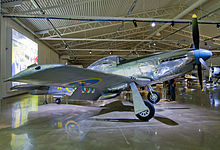 Swedish Air Force P-51D on display at Swedish Air Force Museum
Swedish Air Force P-51D on display at Swedish Air Force Museum
- The Swiss Air Force operated a few USAAF P-51s that had been impounded by Swiss authorities during World War II after the pilots were forced to land in neutral Switzerland. After the war, Switzerland also bought 130 P-51s for $4,000 each. They served until 1958.[41]
 United Kingdom
United Kingdom- The RAF was the first air force to operate the Mustang. Because the first Mustangs were built to British requirements, these planes used factory numbers and were not P-51s; the order comprised 320 NA-73s, followed by 300 NA-83s, all of which were designated North American Mustang Mark Is by the RAF.[63] The first RAF Mustangs diverted from American orders were 93 P-51s, designated Mark IA, followed by 50 P-51As used as Mustang IIs.[64]
- The first Mustang Mk Is entered service in 1941 the first unit being 2 Squadron RAF. Due to poor high-altitude performance, the Mustangs were used by Army Co-operation Command, rather than Fighter Command, and were used for tactical reconnaissance and ground-attack duties. On 27 July 1942, 16 RAF Mustangs undertook their first long-range reconnaissance mission over Germany. During Operation Jubilee (19 August 1942) four British and Canadian Mustang squadrons, including 26 Squadron saw action. By 1943/1944, British Mustangs were used extensively to seek out V-1 flying bomb sites. The final RAF Mustang Mk I and Mustang Mk II aircraft were struck off charge in 1945.
- The RAF also operated a total of 308 P-51Bs and 636 P-51Cs[65] which were known in RAF service as Mustang Mk IIIs; the first units converted to the type in late 1943 and early 1944. Mustang Mk III units were operational until the end of World War II, though many units had already converted to the Mustang Mk IV and Mk IVAs (828 in total, comprising 282 P-51D-NAs or Mk IVs, and 600 P-51Ks or Mk IVA).[66] As the Mustang was a Lend-Lease type, all aircraft still on RAF charge at the end of the war were either returned to the USAAF "on paper" or retained by the RAF for scrapping. The final Mustangs were retired from RAF use in 1947.[41]
 Soviet Union
Soviet Union- The Soviet Union received at least 10 early-model ex-RAF Mustang Is and tested but found them to "under-perform" compared to contemporary USSR fighters, relegating them to training units. Later Lend-Lease deliveries of the P-51B/C and D series along with other Mustangs abandoned in Russia after the famous "shuttle missions" were repaired and used by the Soviet Air Force, but not in front-line service.[67]
 Uruguay
Uruguay- The Uruguayan Air Force (FAU) used 25 P-51D Mustangs from 1950 to 1960—some were subsequently sold to Bolivia.[41]
P-51s and civil aviation
Many P-51s were sold as surplus after the war, often for as little as $1,500. Some were sold to former wartime fliers or other aficionados for personal use, while others were modified for air racing.[68]
One of the most significant Mustangs involved in air racing was a surplus P-51C-10-NT (44-10947) purchased by Paul Mantz, a film stunt pilot. The aircraft was modified by creating a "wet wing", sealing the wing to create a giant fuel tank in each wing, which eliminated the need for fuel stops or drag-inducing drop tanks. This Mustang, called Blaze of Noon, came in first in the 1946 and 1947 Bendix Air Races, second in the 1948 Bendix, and third in the 1949 Bendix. He also set a U.S. coast-to-coast record in 1947. The Mantz Mustang was sold to Charles F. Blair Jr (future husband of Maureen O'Hara) and re-named Excalibur III. Blair used it to set a New York-to-London (c. 3,460 mi/5,568 km) record in 1951: 7 hr 48 min from takeoff at Idlewild to overhead London Airport. Later that same year, he flew from Norway to Fairbanks, Alaska, via the North Pole (c. 3,130 mi/5,037 km), proving that navigation via sun sights was possible over the magnetic north pole region. For this feat, he was awarded the Harmon Trophy, and the Air Force was forced to change its thoughts on a possible Soviet air strike from the north. This Mustang now resides in the National Air and Space Museum at Steven F. Udvar-Hazy Center.[69]
The most prominent firm to convert Mustangs to civilian use was Trans-Florida Aviation, later renamed Cavalier Aircraft Corporation, which produced the Cavalier Mustang. Modifications included a taller tailfin and wingtip tanks. A number of conversions included a Cavalier Mustang specialty: a "tight" second seat added in the space formerly occupied by the military radio and fuselage fuel tank.
In 1958, 78 surviving RCAF Mustangs were retired from service's inventory and were ferried from their varied storage locations to Canastota, New York where the American buyers had been located. These aircraft make up a large percentage of the aircraft presently flying worldwide.[70]
In the late 1960s and early 1970s, when the United States Department of Defense wished to supply aircraft to South American countries and later Indonesia for close air support and counter insurgency, it turned to Cavalier to return some of their civilian conversions back to updated military specifications.
In the 21st century a P-51 can command a price of more than $1 million, even for only partially restored aircraft.[70] According to the FAA there are 204 privately owned P-51s in the U.S.[71] Most of which are still flying, often associated with organizations such as the Commemorative Air Force (formerly the Confederate Air Force).[72]
Variants
Main article: North American P-51 variantsProduction
- Source: U.S. Military Aircraft Designations and Serials since 1909[73]
- NA.73X Prototype: One built
- P-51: 150 built
- P-51A: 310 built at Inglewood, California
- P-51B: 1,988 built at Inglewood
- P-51C: 1,750 built at Dallas, Texas
- P-51D: A total of 8,156 were built: 6,502 at Inglewood, 1,454 at Dallas and 200 by CAC at Fisherman's Bend, Australia
- XP-51F: Three built
- XP-51G: Two built
- P-51H: 555 built at Inglewood
- XP-51J: Two built
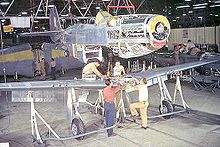 P-51D being assembled, Inglewood, California.[nb 4]
P-51D being assembled, Inglewood, California.[nb 4]
- P-51K: 1,500 built
- P-51L: None built — cancelled
- P-51M: One built at Dallas
- Mustang Mk I: 620 built
- Mustang Mk III: 852 built
- Mustang Mk IV: 281 built
- Mustang Mk IVA: 595 built
Total number built: 16,766 (most numerous American fighter aircraft)
Scale replicas
The P-51 has been the subject of numerous scale flying replicas; aside from ever-popular R/C-controlled aircraft, several kitplane manufacturers offer ½, ⅔, and ¾-scale replicas capable of comfortably seating one (or even two) and offering high performance combined with more forgiving flight characteristics. Such aircraft include the Titan T-51 Mustang, W.A.R. P-51 Mustang, Linn Mini Mustang, Jurca Mustang, Thunder Mustang, and Loehle 5151 Mustang.
Survivors
Main article: List of surviving North American P-51 MustangsSpecifications
P-51D Mustang
Data from Erection and Maintenance Manual for P-51D and P-51K.[74] The Great Book of Fighters,[75] and Quest for Performance[76]
General characteristics
- Crew: 1
- Length: 32 ft 3 in (9.83 m)
- Wingspan: 37 ft 0 in (11.28 m)
- Height: 13 ft 4½ in (4.08 m:tail wheel on ground, vertical propeller blade.)
- Wing area: 235 ft² (21.83 m²)
- Empty weight: 7,635 lb (3,465 kg)
- Loaded weight: 9,200 lb (4,175 kg)
- Max takeoff weight: 12,100 lb (5,490 kg)
- Powerplant: 1 × Packard V-1650-7 liquid-cooled supercharged V-12, 1,490 hp (1,111 kW) at 3,000 rpm;[77] 1,720 hp (1,282 kW) at WEP
- Zero-lift drag coefficient: 0.0163
- Drag area: 3.80 ft² (0.35 m²)
- Aspect ratio: 5.83
Performance
- Maximum speed: 437 mph (703 km/h) at 25,000 ft (7,600 m)
- Cruise speed: 362 mph (580 km/h)
- Stall speed: 100 mph (160 km/h)
- Range: 1,650 mi (2,755 km) with external tanks
- Service ceiling: 41,900 ft (12,800 m)
- Rate of climb: 3,200 ft/min (16.3 m/s)
- Wing loading: 39 lb/ft² (192 kg/m²)
- Power/mass: 0.18 hp/lb (300 W/kg)
- Lift-to-drag ratio: 14.6
- Recommended Mach limit 0.8
Armament
- 6× 0.50 caliber (12.7mm) M2 Browning machine guns with 1,880 total rounds (400 rounds for each on the inner pair, and 270 rounds for each of the outer two pair)
- 2× hardpoints for up to 2,000 lb (907 kg) of bombs
- 6 or 10× T64 5.0 in (127 mm) H.V.A.R rockets (P-51D-25, P-51K-10 on)[nb 5]
P-51H Mustang
Data from The Great Book of Fighters[75]
General characteristics
- Crew: 1
- Length: 33 ft 4 in (10.16 m)
- Wingspan: 37 ft 0 in (11.28 m)
- Height: 11 ft 1 in (3.38 m)
- Wing area: 235 ft² (21.83 m²)
- Empty weight: 7,040 lb (3,195 kg)
- Loaded weight: 9,500 lb (4,310 kg)
- Max takeoff weight: 11,500 lb (5,215 kg)
- Powerplant: 1 × Packard V-1650-9 liquid-cooled supercharged V-12, 1,490 hp (1,111 kW) at 3,000 rpm, 2,220 hp (1,655 kW) at WEP[80]
Performance
- Maximum speed: 487 mph (784 km/h) at 25,000 ft (7,600 m)
- Range: 1,160 mi (1,865 km) with external tanks
- Service ceiling: 41,600 ft (12,700 m)
- Rate of climb: 3,300 ft/min (16.8 m/s)
- Wing loading: 40.4 lb/ft² (197.4 kg/m²)
- Power/mass: 0.23 hp/lb (385 W/kg)
Armament
- 6× 0.50 inch (12.7mm) M2 Browning machine guns with 1,880 total rounds (400 rounds for each on the inner pair, and 270 rounds for each of the outer two pair), or 4 of the same guns with 1,600 total rounds (400 rpg)
Notable appearances in media
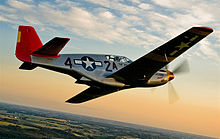 The restored P-51C Mustang associated with the Tuskegee Airmen now flown by Red Tail Project as described in Red Tail Reborn
The restored P-51C Mustang associated with the Tuskegee Airmen now flown by Red Tail Project as described in Red Tail Reborn
- Battle Hymn (1956) is based on the real-life experiences of Lt Col Dean E. Hess, USAF (played by Rock Hudson) and his cadre of U.S. Air Force instructors in the early days of the Korean War, training the pilots of the Republic of Korea Air Force and leading them in their baptism of fire in F-51D/F-51Ks.
- The Tuskegee Airmen (1995), the story of how a group of African-American pilots overcame racist opposition to become one of the finest U.S. fighter groups in World War II, flying P-51s, although the 99th Squadron would have used P-40 and P-39 during their North African stint.[81]
- Red Tail Reborn (2007), the story behind the restoration of a flying memorial plane.
See also
- Related development
- Cavalier Mustang
- North American A-36
- Rolls-Royce Mustang Mk.X
- North American F-82 Twin Mustang
- North American FJ-1 Fury
- Piper PA-48 Enforcer
- Titan T-51 Mustang
- Aircraft of comparable role, configuration and era
- CAC CA-15 Kangaroo
- Focke-Wulf Fw 190
- Focke-Wulf Ta 152
- Lavochkin La-9
- Martin-Baker MB 5
- Supermarine Spitfire
- Related lists
- List of military aircraft of the United States
- List of fighter aircraft
- Allied technological cooperation during World War II
References
Notes
- ^ All but three of these FGs flew P-38s, P-40s, or P-47s before converting to the Mustang.
- ^ The prototype of the Mark 23, A68-1001, ex 44-13293, was used as a development aircraft by CAC prior to assembling the CA-17s and was re-engined with a Rolls-Royce Merlin 70 to assess the suitability of the British built engine.[37]
- ^ "Ziemi Czerwieńskiej" = "Land of Czerwien", "Warszawski" = "City of Warsaw", "Toruński" = "City of Toruń", "Dębliński" = "City of Deblin", "Kościuszko" = named after Tadeusz Kościuszko; RAF Polish units retained the name and the logo of a squadron from the Polish Air Force which fought the Germans in 1939.
- ^ Note that all panel lines on the upper wings have been carefully filled, smoothed and primed before application of (on natural metal Mustangs) final coats of high speed silver lacquer. Even small flaws on the surface of P-51 wings could cut performance.
- ^ The P-51D and K Maintenance manual notes that carrying 1,000 lb bombs was not recommended because the racks were not designed for them.[78] Three rockets could be carried on removable 'Zero Rail' launchers with the wing racks installed, 10 without wing racks.[79]
Citations
- ^ National Air Force Museum fact sheet
- ^ a b Knaack 1978.
- ^ Kinzey 1996, p.5.
- ^ a b Gunston 1984, p. 58.
- ^ Pearcy 1996, p. 15.
- ^ Pearcy 1996, p. 30.
- ^ a b Delve 1999, p. 11.
- ^ a b Delve 1999, p. 12.
- ^ Selig, Michael. "P-51D wingroot section." uiuc.edu. Retrieved: 22 March 2008
- ^ "Discussion of laminar flow on P-51 wing." yarchive.net/mil. Retrieved: 4 July 2008.
- ^ Wagner 2000, pp. 16, 18.
- ^ Yenne 1989, p. 49.
- ^ Liming 1944.[page needed]
- ^ Liming 1979.[page needed]
- ^ "P-51 History: Mustang I." The Gathering of Mustangs & Legends. Retrieved: 26 March 2009.
- ^ Hastings 1979, pp. 214-215.
- ^ Dean 1997, p. 338.
- ^ Donald Caldwell and Richard Muller, "The Luftwaffe over Germany — Defense of the Reich", Greenhill books, MBI Publishing, 2007, pg. 162-163
- ^ Jeffrey Ethell, Robert Sand, "World War II Fighters", Zenith Imprint, 2002, pg. 126
- ^ Spick 1983, p. 111.
- ^ Bowen 1980[page needed]
- ^ Sherman, Steven. "Aces of the Eighth Air Force in World War Two." acepilots.com, June 1999. Retrieved: 7 August 2011.
- ^ Olmsted 1994, p. 144.
- ^ Forsyth 1996, pp. 149, 194.
- ^ Scutts 1994, p. 58.
- ^ a b c Glancey 2006, p. 188.
- ^ Dean 1997, p. 339.
- ^ "4th Fighter Wing." Global Security. Retrieved: 12 April 2007.
- ^ Thompson with Smith 2008, p. 233.
- ^ Sims 1980, pp. 134–135.
- ^ Sims 1980, pp. 197–202.
- ^ USAF Fact sheet
- ^ a b Gunston, Bill. North American P-51 Mustang. New York: Gallery Books, 1990. ISBN 0-8317-1402-6.
- ^ Wixey 2001, p. 55.
- ^ Dominican Republic
- ^ Munson 1969, p. 97.
- ^ a b c d Anderson 1975, p. 3.
- ^ Anderson 1975, pp. 16–43.
- ^ Anderson 1975, pp. 50–65.
- ^ Anderson 1975, p. 71.
- ^ a b c d e f g h i j k l m n o p q Gunston 1990 p. 39.
- ^ Hagedorn 1993, p. 147
- ^ Hagedorn 2006[page needed]
- ^ Dienst 1985
- ^ Gunston and Dorr 1995, p. 107.
- ^ Gunston and Dorr 1995, pp. 109–110.
- ^ Smith et al 2004, pp. 78–79, 80, 82.
- ^ Smith et al. 2004, pp. 108–114.
- ^ Gilman and Clive 1978, p. 314.
- ^ Gunston and Dorr 1995, p. 108.
- ^ Cavalier Mustangs Mustangs-Mustangs. Retrieved: 12 April 2007.
- ^ "Indonesian Air Arms Overview". Scramble: Dutch Aviation Society. Retrieved: 12 April 2007.
- ^ Darling 2002, p. 66.
- ^ Yenne 1989, p. 62.
- ^ Sgarlato 2003[page needed]
- ^ Kahin (2003), p.90
- ^ a b Wilson 2010, p. 42.
- ^ "Blue Diamonds: Philippine Air Force." geocities.com. Retrieved: March 21, 2008.
- ^ "309 Sqn photo gallery." polishairforce.pl. Retrieved: 18 February 2010.
- ^ Mietelski 1981North American P-51 Mustang
- ^ "Somali (SOM)." World Air Forces. Retrieved: 10 September 2011.
- ^ Andersson, Lennart and Leif Hellström. Bortom Horisonten: Svensk Flygspaning mot Sovjetunionen 1946-1952 (in Swedish). Stockholm: All about Hobbies, 2009. ISBN 978-91-7243-015-0.
- ^ Gruenhagen 1980, p.193.
- ^ Gruenhagen 1980, pp. 195–196.
- ^ Gruenhagen 1980, pp. 199–200.
- ^ Gruenhagen 1980, pp. 201, 205
- ^ Gordon 2008, pp. 448–449.
- ^ Swiss Mustangs.
- ^ Mustang "NA P-51C Mustang." NASM. Rerieved: 30 September 2010.
- ^ a b "P-51s for Sale." mustangsmustangs.net. Retrieved: 30 September 2010.
- ^ "North American P-51". FAA Registry. Retrieved: 15 May 2011.
- ^ "Aircraft rides." Dixie Wing. Retrieved: 1 September 2010.
- ^ Andrade, John M. U.S. Military Aircraft Designations and Serials since 1909. Leicester, UK: Midland Counties Publication, 1979, ISBN 0-904597-22-9.
- ^ AN 01-60JE-2 1944.
- ^ a b Green and Swanborough 2001
- ^ Loftin 2006.
- ^ "Objects: A19520106000 — Packard (Rolls-Royce) Merlin V-1650-7." Smithsonian National Air and Space Museum, Collections Database.
- ^ AN 01-60JE-2 1944, pp. 398-399.
- ^ AN 01-60JE-2 1944, p. 400.
- ^ "Mustang Specifications and Performance." Flight Journal (archived P-51 webpage).
- ^ Johnson, F.A. Airacobra & Kingcobra. Warbird Tech Series Vol. 17, 1998, p. 72.
Bibliography
- Aerei da combattimento della Seconda Guerra Mondiale (in Italian). Novara, Italy: De Agostini Editore, 2005.
- Anderson, Peter N. Mustangs of the RAAF and RNZAF. Sydney, Australia: A.H. & A.W. Reed Pty Ltd, 1975. ISBN 0-589-07130-0.
- Angelucci, Enzo and Peter Bowers. The American Fighter: The Definitive Guide to American Fighter Aircraft from 1917 to the Present. New York: Orion Books, 1985. ISBN 0-517-56588-9.
- Birch, David. Rolls-Royce and the Mustang. Derby, UK: Rolls-Royce Heritage Trust, 1987. ISBN 0-9511710-0-3.
- Bowen, Ezra. Knights of the Air (Epic of Flight). New York: Time-Life Books, 1980. ISBN 0-8094-3252-8.
- Bowman, Martin W. P-51 Mustang vs Fw 190: Europe 1943-45. Oxford, UK: Osprey Publishing, 2007. ISBN 1-84603-189-3.
- Boyne, Walter J. Clash of Wings. New York: Simon & Schuster, 1994. ISBN 0-684-83915-6.
- Breffort, Dominique with André Jouineau. Le North-American P-51 Mustang — de 1940 à 1980 (Avions et Pilotes 5)(in French). Paris: Histoire et Collections, 2003. ISBN 2-913903-80-0.
- Bridgman, Leonard, ed. "The North American Mustang." Jane’s Fighting Aircraft of World War II. London: Studio, 1946. ISBN 1-85170-493-0.
- Carson, Leonard "Kit." Pursue & Destroy. Granada Hills, California: Sentry Books Inc., 1978. ISBN 0-913194-05-0.
- Carter, Dustin W. and Birch J. Matthews.Mustang: The Racing Thoroughbred. West Chester, Pennsylvania: Schiffer Publishing Company, 1992. ISBN 978-0887403910.
- Darling, Kev. P-51 Mustang (Combat Legend). Shrewsbury, UK: Airlife, 2002. ISBN 1-84037-357-1.
- Davis, Larry. P-51 Mustang. Carrollton, Texas: Squadron/Signal Publications, Inc., 1995. ISBN 0-89747-350-7.
- Dean, Francis H. America's Hundred Thousand. Atglen, Pennsylvania: Schiffer Publishing Ltd., 1997. ISBN 0-7643-0072-5.
- Delve, Ken. The Mustang Story. London: Cassell & Co., 1999. ISBN 1-85409-259-6.
- Dienst, John and Dan Hagedorn. North American F-51 Mustangs in Latin American Air Force Service. London: Aerofax 1985. ISBN 0-942548-33-7.
- Donald, David, ed. Encyclopedia of World Aircraft. Etobicoke, Ontario: Prospero, 1997. ISBN 1-85605-375-X.
- Dorr, Robert F.. P-51 Mustang (Warbird History). St. Paul, Minnesota: Motorbooks International Publishers, 1995. ISBN 0-7603-0002-X.
- Ethell, Jeffrey L. Mustang: A Documentary History of the P-51. London: Jane's Publishing, 1981. ISBN 0-531-03736-3
- Ethell, Jeffrey L. P-51 Mustang: In Color, Photos from World War II and Korea. St. Paul, Minnesota: Motorbooks International Publishers & Wholesalers, 1993. ISBN 0-87938-818-8.
- Forsyth, Robert. JV44: The Galland Circus. Burgess Hill, West Sussex, UK: Classic Publications, 1996. ISBN 0-9526867-0-8
- Furse, Anthony. Wilfrid Freeman: The Genius Behind Allied Survival and Air Supremacy, 1939 to 1945. Staplehurst, UK: Spellmount, 1999. ISBN 1-86227-079-1.
- Gilman J.D. and J. Clive. KG 200. London: Pan Books Ltd., 1978. ISBN 0-85177-819-4.
- Glancey, Jonathan. Spitfire: The Illustrated Biography. London: Atlantic Books, 2006. ISBN 978-1-84354-528-6.
- Gordon, Yefim. Soviet Air Power in World War 2. Hinckley, UK: Midland Ian Allan Publishing, 2008. ISBN 978-85780-304-4.
- Grant, William Newby. P-51 Mustang. London: Bison Books, 1980. ISBN 0-89009-320-2.
- Green, William and Gordon Swanborough. The Great Book of Fighters. St. Paul, Minnesota: MBI Publishing, 2001. ISBN 0-7603-1194-3.
- Gruenhagen, Robert W. Mustang: The Story of the P-51 Fighter (rev. ed.). New York: Arco Publishing Company, Inc., 1980. ISBN 0-668-04884-0.
- Gunston, Bill. North American P-51 Mustang. New York: Gallery Books, 1990. ISBN 0-8317-1402-6.
- Gunston, Bill and Robert F. Dorr. "North American P-51 Mustang: The Fighter That Won the War." Wings of Fame, Volume 1. London: Aerospace, 1995, pp. 56–115. ISBN 1-874023-74-3.
- Gunston, Bill. Aerei della seconda guerra mondiale (in Italian). Milan: Peruzzo editore, 1984. No ISBN.
- Hagedorn, Dan. Central American and Caribbean Air Forces. Tonbridge, Kent, UK: Air-Britain (Historians), 1993. ISBN 0-85130-210-6.
- Hagedorn, Dan. Latin American Air Wars & Aircraft. Tokyo: Hikoki, 2006. ISBN 1-902109-44-9.
- Hess, William N. Fighting Mustang: The Chronicle of the P-51. New York: Doubleday and Company, 1970. ISBN 0-912173-04-1.
- Jackson, Robert. Aircraft of World War II: Development, Weaponry, Specifications. Edison, New Jersey: Chartwell Books, 2003. ISBN 0-7858-1696-8.
- Jerram, Michael F. P-51 Mustang. Yeovil, UK: Winchmore Publishing Services Ltd., 1984, ISBN 0-85429-423-6.
- Johnsen, Frederick A. North American P-51 Mustang. North Branch, Minnesota: Specialty Press Publishers and Wholesalers, 1996. ISBN 0-933424-68-X.
- Kaplan, Philip. Fly Navy: Naval Aviators and Carrier Aviation: A History. New York: Michael Friedman Publishing Group Incorporated, 2001. ISBN 1-58663-189-6.
- Kinzey, Bert. P-51 Mustang in Detail & Scale: Part 1; Prototype through P-51C. Carrollton, Texas: Detail & Scale Inc., 1996. ISBN 1-888974-02-8
- Kinzey, Bert. P-51 Mustang in Detail & Scale: Part 2; P-51D thu P-82H. Carrollton, Texas: Detail & Scale Inc., 1997. ISBN 1-888974-03-6
- Knaack, Marcelle Size. Encyclopedia of U.S. Air Force Aircraft and Missile Systems: Volume 1 Post-World War II Fighters 1945-1973. Washington, DC: Office of Air Force History, 1978. ISBN 0-912799-59-5.
- Lednicer, David A. and Ian J. Gilchrist. "A Retrospective: Computational Aerodynamic Analysis Methods Applied to the P-51 Mustang." AIAA paper 91-3288, September 1991.
- Lednicer, David A. "Technical Note: A CFD Evaluation of Three Prominent World War II Fighter Aircraft." Aeronautical Journal, Royal Aeronautical Society, June/July 1995.
- Lednicer, David A. "World War II Fighter Aerodynamics." EAA Sport Aviation, January 1999.
- Leffingwell, Randy (and David Newhardt, photography). Mustang: 40 Years. St. Paul, Minnesota: Crestline (Imprint of MBI Publishing Company), 2003. ISBN 0-7603-2122-1.
- Liming, R.A. Mathematics for Computer Graphics. Fallbrook, California: Aero Publishers, 1979. ISBN 978-0-81686-751-6.
- Liming, R.A. Practical Analytic Geometry With Applications to Aircraft. New York: The MacMillan Company, 1944.
- Loftin, LK, Jr. Quest for Performance: The Evolution of Modern Aircraft, NASA SP-468. Washington, DC: NASA History Office. Retrieved: 22 April 2006.
- Lowe, Malcolm V. North American P-51 Mustang (Crowood Aviation Series). Ramsbury, Wiltshire, UK: Crowood Press, 2009. ISBN 978-1-86126-830-3.
- Loving, George. Woodbine Red Leader: A P-51 Mustang Ace in the Mediterranean Theater." Ballantine Books. 2003. ISBN 0-89141-813-X
- Matricardi, Paolo. Aerei militari: Caccia e Ricognitori(in Italian). Milan: Mondadori Electa, 2006.
- Mietelski, Michał, Samolot myśliwski Mustang Mk. I-III wyd. I (in Polish). Warszawa: Wydawnictwo Ministerstwa Obrony Narodowej, 1981. ISBN 83-11-06604-3.
- Munson, Kenneth. Caccia e aerei da attacco e addestramento dal 1946 ad oggi(in Italian). Torino: Editrice S.A.I.E., 1969. No ISBN.
- O'Leary, Michael. P-51 Mustang: The Story of Manufacturing North American's Legendary World War II Fighter in Original Photos. North Branch, Minnesota: Specialty Press, 2010. ISBN 978-1-58007-152-9.
- O'Leary, Michael. USAAF Fighters of World War Two. New York: Sterling Publishing Co., 1986. ISBN 0-7137-1839-0.
- Olmsted, Merle. The 357th Over Europe: the 357th Fighter Group in World War II. St. Paul, Minnesota: Phalanx Publishing, 1994. ISBN 0-933424-73-6.
- Pearcy, Arthur. Lend-Lease Aircraft in World War II. Shrewsbury, UK: Airlife Publishing Ltd., 1996. ISBN 1-85310-443-4.
- Sgarlato, Nico. "Mustang P-51" (in Italian). I Grandi Aerei Storici (Monograph series) N.7, November 2003. Parma, Italy: Delta Editrice. ISSN 1720-0636.
- Sims, Edward H. Fighter Tactics and Strategy 1914-1970. Fallbrook, California: Aero publisher Inc., 1980. ISBN 0-8168-8795-0.
- Smith, J. Richard, Eddie J. Creek and Peter Petrick. On Special Missions: The Luftwaffe's Research and Experimental Squadrons 1923-1945 (Air War Classics). Hersham, Surrey, UK: Classic Publications, 2004. ISBN 1-903223-33-4.
- Spick, Mike. Fighter Pilot Tactics. The Techniques of Daylight Air Combat. Cambridge, UK: Patrick Stephens, 1983. ISBN 0-85059-617-3.
- Thompson, J. Steve with Peter C. Smith. Air Combat Manoeuvres: The Technique and History of Air Fighting for Flight Simulation. Hersham, Surrey, UK: Ian Allan Publishing, 2008. ISBN 978-1-903223-98-7.
- United States Air Force Museum Guidebook. Wright-Patterson AFB, Ohio: Air Force Museum Foundation, 1975.
- United States Army Air Force. AN 01-60JE-2: Maintenance and Erection Instructions for Army Model P-51D-5, -10, -15, 20, -25; P-51K-1, -5, -10, -15; British Model Mustang IV Aeroplanes. Evansville, Indiana: U.S.A.A.F, 1944.
- Wagner, Ray. American Combat Planes of the 20th Century. Reno, Nevada: Jack Bacon & Company, 2004. ISBN 978-0-930083-17-5.
- Wagner, Ray. Mustang Designer: Edgar Schmued and the P-51. Herndon, Virginia: Smithsonian Institution Press, 2000. ISBN 978-1-56098-994-3.
- Walker, Jeff. "Empire of the Sun." Air Classics, Volume 24, Number 1, January 1988.
- White, Graham. Allied Aircraft Piston Engines of World War II. Warrendale, Pennsylvania: Society for Automotive Engineers, 1995. ISBN 1-56091-655-9.
- Wilson, Stewart, ed. "Mustang Warbirds: Civil Registered Mustangs of Australia and New Zealand Then and Now." Warbirds of Australia and New Zealand 2010. St Leonards, New South Wales, Australia: Chevron Publishing Group, 2010.
- Wixey, Ken. "Magnificent Mustang: A Production History of the North American P-51." Air Enthusiast, Issue 95, September/October 2001.
- Yenne, Bill: Rockwell: The Heritage of North American. New York: Crescent Books, 1989. ISBN 0-517-67252-9.
External links
- "A Fighter From the Ground Up." Popular Science, July 1943, one of earliest detailed articles on P-51A
- "Wild Horses of the Sky," Popular Mechanics, November 1943
- Joe Baugher, North American P-51 Mustang
- Swiss Mustangs
- Camouflage and Markings of P-51 Mustang Parts 1-4 USAAF plus Allison engine versions RAF and Commonwealth
- P-51 Warbird Registry: names, serial numbers, images
- Cuban F-51 Mustangs
- Allison-powered Mustang performance test reports; 1940, 1942, 1943, 1944
- P-51B Mustang performance test report, May 1943
- The Mustang XP-51G
- P-51 combat reports
- NACA-WR-L-566 "Flying qualities and stalling characteristics of North American XP-51 airplane", April 1943. (PDF)
- Information on P-51 versions and survivors
North American Aviation and North American Aviation division of Rockwell International Aircraft Manufacturer
"Charge Number"NA-15 · NA-16 · NA-17 (components) · NA-18 · NA-19 · NA-20 · NA-21 · NA-22 · NA-23 · NA-24 (components) · NA-25 · NA-26 · NA-27 · NA-28 · NA-29 · NA-30 · NA-31 · NA-32 · NA-33 · NA-34 · NA-35 · NA-36 · NA-37 · NA-38 · NA-39 · NA-40 · NA-41 · NA-42 · NA-43 · NA-44 · NA-45 · NA-46 · NA-47 · NA-48 · NA-49 · NA-50 · NA-51 · NA-52 · NA-53 · NA-54 · NA-55 · NA-56 · NA-57 · NA-58 · NA-59 · NA-60 · NA-60 · NA-61 · NA-62 · NA-63 · NA-64 · NA-65 · NA-66 · NA-67 · NA-68 · NA-69 · NA-70 · NA-71 · NA-72 · NA-73 · NA-73 · NA-74 · NA-75 · NA-76 · NA-77 · NA-78 · NA-79 · NA-81 · NA-82 · NA-83 · NA-84 · NA-85 · NA-87 · NA-88 · NA-89 · NA-90 · NA-91 · NA-92 · NA-93 · NA-94 · NA-95 · NA-96 · NA-97 · NA-98 · NA-99 · NA-100
NA-101 · NA-102 · NA-103 · NA-104 · NA-105 · NA-106 · NA-107 · NA-108 · NA-109 · NA-110 · NA-111 · NA-112 · NA-113 · NA-114 · NA-115 · NA-116 · NA-117 · NA-118 · NA-119 · NA-120 · NA-121 · NA-122 · NA-123 · NA-124 · NA-125 · NA-126 · NA-127 · NA-128 · NA-129 · NA-130 · NA-132 · NA-134 · NA-135 · NA-137 · NA-138 · NA-139 · NA-140 · NA-141 · NA-142 · NA-143 · NA-144 · NA-145 · NA-146 · NA-147 · NA-148 · NA-149 · NA-150 · NA-151 · NA-152 · NA-153 · NA-154 · NA-155 · NA-156 · NA-157 · NA-158 · NA-159 · NA-160 · NA-161 · NA-162 · NA-163 · NA-164 · NA-165 · NA-166 · NA-167 · NA-168 · NA-169 · NA-170 · NA-171 · NA-172 · NA-173 · NA-174 · NA-175 · NA-176 · NA-177 · NA-178 · NA-179 · NA-180 · NA-181 · NA-182 · NA-183 · NA-184 · NA-185 · NA-186 · NA-187 · NA-188 · NA-189 · NA-190 · NA-191 · NA-192 · NA-193 · NA-194 · NA-195 · NA-196 · NA-197 · NA-198 · NA-199 · NA-200
NA-201 · NA-202 · NA-203 · NA-204 · NA-205 · NA-206 · NA-207 · NA-208 · NA-209 · NA-210 · NA-211 · NA-212 · NA-213 · NA-214 · NA-215 · NA-216 · NA-217 · NA-218 · NA-219 · NA-220 · NA-221 · NA-222 · NA-223 · NA-224 · NA-225 · NA-226 · NA-227 · NA-228 · NA-229 · NA-230 · NA-231 · NA-232 · NA-233 · NA-234 · NA-235 · NA-236 · NA-237 · NA-238 · NA-239 · NA-240 · NA-241 · NA-242 · NA-243 · NA-244 · NA-245 · NA-246 · NA-247 · NA-248 · NA-249 · NA-251 · NA-252 · NA-253 · NA-254 · NA-255 · NA-256 · NA-257 · NA-258 · NA-259 · NA-260 · NA-261 · NA-262 · NA-263 · NA-264 · NA-265 · NA-266 · NA-267 · NA-268 · NA-269 · NA-270 · NA-271 · NA-272 · NA-273 · NA-274 · NA-275 · NA-276 · NA-277 · NA-278 · NA-279 · NA-280 · NA-281 · NA-282 · NA-283 · NA-284 · NA-285 · NA-286 · NA-287 · NA-288 · NA-289 · NA-290 · NA-291 · NA-292 · NA-293 · NA-294 · NA-295 · NA-296 · NA-297 · NA-298 · NA-299 · NA-300
NA-301 · NA-302 · NA-303 · NA-304 · NA-305 · NA-306 · NA-307 · NA-308 · NA-309 · NA-310 · NA-311 · NA-312 · NA-313 · NA-314 · NA-315 · NA-316 · NA-317 · NA-318 · NA-319 · NA-320 · NA-321 · NA-322 · NA-323 · NA-324 · NA-325 · NA-326 · NA-327 · NA-328 · NA-329 · NA-330 · NA-331 · NA-332 · NA-333 · NA-334 · NA-336 · NA-337 · NA-338 · NA-340 · NA-341 · NA-342 · NA-343 · NA-344 · NA-345 · NA-346 · NA-347 · NA-348 · NA-349 · NA-350 · NA-351 · NA-352 · NA-353 · NA-354 · NA-356 · NA-357 · NA-358 · NA-359 · NA-360 · NA-361 · NA-362 · NA-363 · NA-364 · NA-365 · NA-366 · NA-367 · NA-369 · NA-370 · NA-371 · NA-372 · NA-373 · NA-374 · NA-375 · NA-376 · NA-377 · NA-378 · NA-379 · NA-380 · NA-382 · NA-383 · NA-384 · NA-385 · NA-386 · NA-387 · NA-388 · NA-389 · NA-390 · NA-391 · NA-392 · NA-393 · NA-394 · NA-395 · NA-396 · NA-397 · NA-398 · NA-300 · NA-400 · NA-401 · NA-402 · NA-403 · NA-404 · NA-405 · NA-406 · NA-407 · NA-420 · NA-430 · NA-431By role Fighters: P-51 · P-64 · F-82 · FJ-1 · FJ-2/3 · FJ-4 · F-86/F-86D · YF-93 · F-100 · F-107 · F-108 · XFV-12
Bombers: XB-21 · B-25 · XB-28 · B-45 · XB-70 · B-1
Observation: O-47 · OV-10
Attack aircraft: A-27 · A-36 · AJ · A2J · A3J/A-5
Trainers: BT-9 · BC-1 · BC-2 · SNJ · T-6 · SN2J · T-28 · T-39 · T-2
Experimental: X-15
Business aircraft: Sabreliner
Missiles: AGM-28 · MQM-42 · AGM-53
Licence production: B-24 · C-82By name USAAS/USAAC/USAAF/USAF fighter designations 1924–1962 Pursuit (pre-1948)
Fighter (post-1948)P-1 • P-2 • P-3 • XP-4 • P-5 • P-6 • XP-7 • XP-8 • XP-9 • XP-10 • P-11 • P-12 • XP-13 • XP-14 • XP-15 • P-16 • XP-17 • XP-18 • XP-19 • YP-20 • XP-21 • XP-22 • XP-23 • YP-24 • Y1P-25 • P-26 • YP-27 • Y1P-28 • P-29 • P-30 • XP-31 • XP-32 • XP-33 • XP-34 • P-35 • P-36 • XP-37 • P-38 • P-39 • P-40 • XP-41 • XP-42 • P-43 • P-44 • XP-45 • XP-46 • P-47 • XP-48 • XP-49 • XP-50 • P-51 • XP-52 • XP-53 • XP-54 • XP-55 • XP-56 • XP-57 • XP-58 • P-59 • YP-60 • P-61/RF-61C • XP-62 • P-63 • P-64 • XP-65 • P-66 • XP-67 • XP-68 • XP-69 • P-70 • XP-71 • XP-72 • XP-73 • (P-74 not assigned) • P-75 • XP-76 • XP-77 • XP-78 • XP-79 • P-80 • XP-81 • P-82 • XP-83 • P-84 • XP-85 • P-86/F-86D • XP-87 • XP-88 • P-89 • XF-90 • XF-91 • XF-92 • YF-93 • F-94 • YF-95 • YF-96 • F-97 • XF-98 • F-99 • F-100 • F-101 • F-102 • XF-103 • F-104 • F-105 • F-106 • F-107 • XF-108 • XF-109 • F-110 • F-111/F-111B
Pursuit, Biplace Fighter, Multiplace YFM-1 • XFM-2
USAAC/USAAF reconnaissance aircraft Swedish Air Force military aircraft designations 1940–present B/S/T/Tp 16 - Sk 16 • B/S 17 • B/S/T 18 • J 19 • J 20 • A/J 21 • J/S 22 • J 23 • B/J 24 - Tp 24 • Sk 25 • Sk 26 - B/S 26 - J/S 26 • J 27 • A/J/Sk 28 • A/J/S 29 • J 30 • S 31 • A/J/S 32 • J 33 • J 34 • J/S/Sk 35 • A 36 • AJ/JA 37 • A/Sk 38 • JAS 39 • Tp 45 • Tp 46 • Tp 47 • Sk 50 • Fpl 51 • Tp 52 • Tp 53 • Fpl 54 - Tp 54 • Tp 55 • Sk 60 • Sk/Fpl 61 • Tp 78 • Tp 79 • Tp 80 • Tp 81 • Tp 82 • Tp 83 • Tp 84 • Tp 85 • Tp 86 • Tp 87 • Tp 88 • Tp 89 • Tp 91 • Tp 100 • Tp 101 • Tp 102 • Tp 103
Lists relating to aviation General Aircraft (manufacturers) · Aircraft engines (manufacturers) · Airlines (defunct) · Airports · Civil authorities · Museums · Registration prefixes · Rotorcraft (manufacturers) · TimelineMilitary Accidents/incidents Records Categories:- United States fighter aircraft 1940–1949
- Racing aircraft
- Military aircraft of the Korean War
- North American Aviation aircraft
- Single-engine aircraft
Wikimedia Foundation. 2010.

